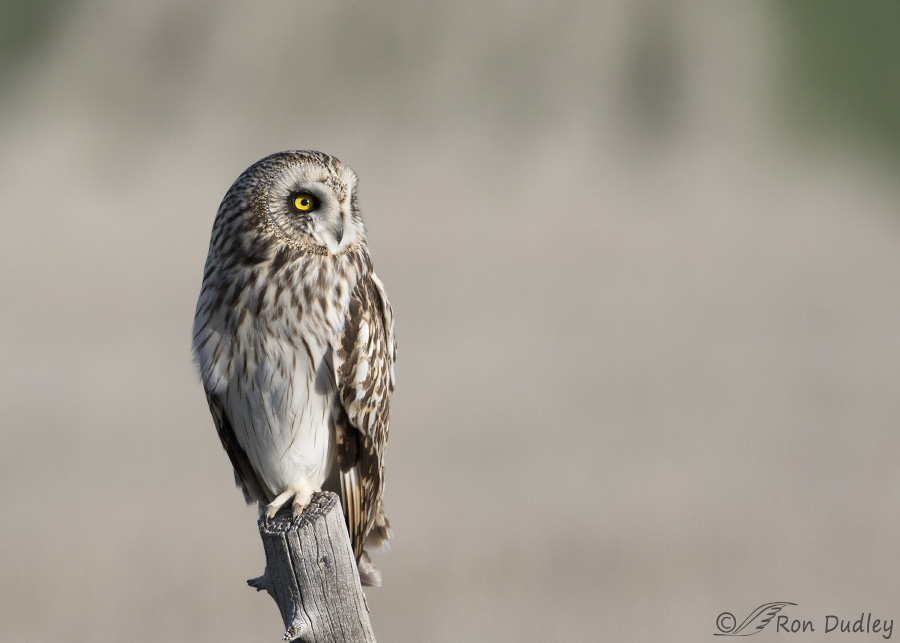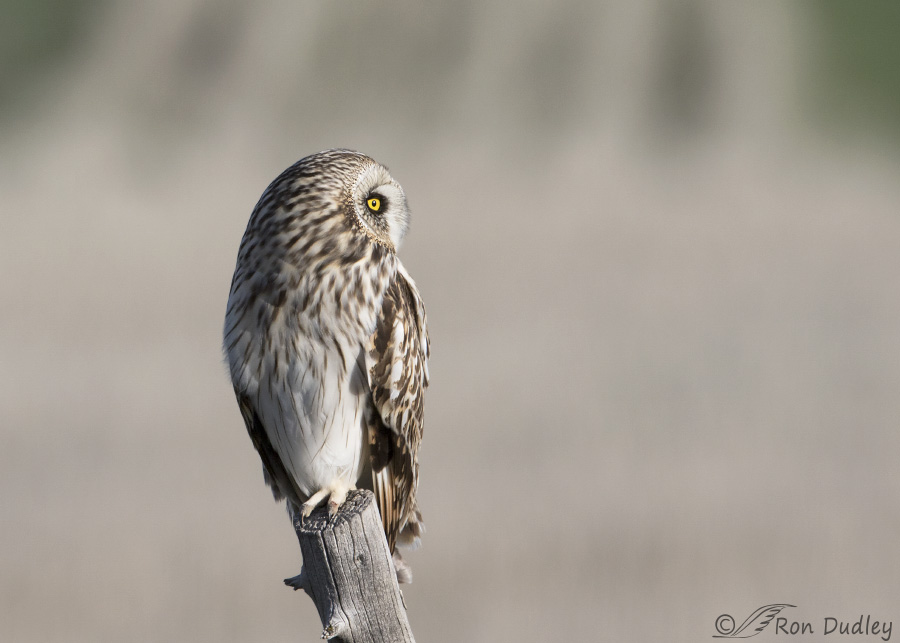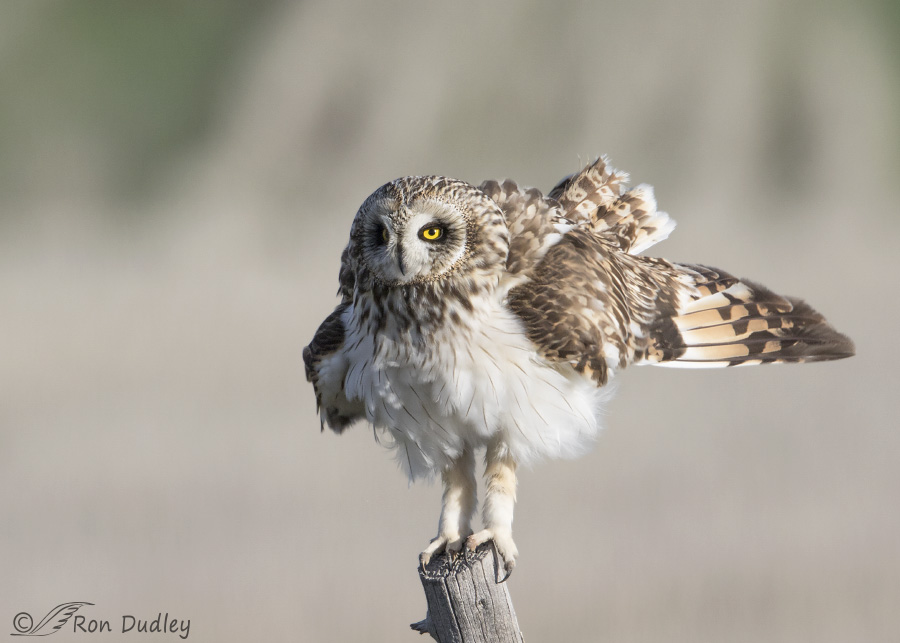And a great look at their feathered legs.
1/4000, f/6.3, ISO 500, Canon 7D Mark II, Canon EF 500mm f/4L IS II USM + EF 1.4 III Extender, not baited, set up or called in
I was hoping that this year would be another great year for Short-eared Owls in northern Utah but it’s not looking like it’s going to happen. There are a few around but numbers don’t seem to be nearly as dense as they were during the 2016 breeding season. Perhaps that’s true only in the areas I regularly haunt and numbers are better elsewhere. I hope so.
I photographed this one five days ago as it perched on an old fence post in partial side light. These images are very nearly monotone and I like that effect.
1/2500, f/7.1, ISO 500, Canon 7D Mark II, Canon EF 500mm f/4L IS II USM + EF 1.4 III Extender, not baited, set up or called in
At first the owl posed for me very little except to move its head in different directions as it scanned for prey in the nearby grasses.
1/2500, f/7.1, ISO 500, Canon 7D Mark II, Canon EF 500mm f/4L IS II USM + EF 1.4 III Extender, not baited, set up or called in
But eventually the bird roused (shook its feathers to rearrange them) and I was able to get several interesting shots as it did so.
One of the things I really like about this image is the very good look at those feathered legs and feet. I seldom get to see them this well but during the rouse the owl extended its legs, raised its “skirt” and erected even those short leg feathers which makes them stand out more than usual. Those feathers extend nearly to the ends of the toes and make the legs appear fuzzy and soft.
Because Short-eared Owls depend on a fluctuating food source (mostly small rodents) they show considerable local variation in numbers and breeding success from year to year – to the point that they’re often considered to be “nomadic”. I hope that explains why I’m seeing fewer of them this year and they’re doing better elsewhere.
Ron





I’m also a big fan of the monochrome look, and have been for a long time. It’s especially beautiful when it includes an SEO. Love seeing the britches so well.
Marvelous shots Ron!
Charlotte
Lovely images, Ron.
Thanks, Donna.
Monochromatic magic.
And of course I love the leggings.
Mind you, my fascination with bird britches and leggings is starting to bother me. A bit.
Ellie Baby–Not to worry! Just think of it as a fuzzy fetish….,
Don’t lose any sleep over your obsession, EC. And I like Patty’s “fuzzy fetish”…
When I was the photo, I was wondering if you had a different name for this feather configuration. Leggings makes sense to me. Only the talons show.
They also remind me of pajama bottoms with foot coverings attached but I don’t know the name for that piece of clothing.
You’re just into legs. Nothing wrong with that! 🙂
Beautiful as usual, the 3rd is “the charm”! How much driving around do you do on average? I’m guessing these are not just around your backyard.
I do a lot of driving for birds, Elmer. This location is almost 100 miles from my home. Some of my other haunts are only about 40-50 miles.
I like the pop of green in the corners of your first two shots. They act like arrows directing my attention right to your subject.
And to echo Patty: a rousing shortie, a weathered post, and a chocolate donut on a beautiful day — all is right with the world in that one moment.
You’re right about those greens Marty, especially the way they seem to slant slightly toward the owl in the second shot.
Ron, I so look forward to your posts every morning and this short-eared owl is no exception. Like you, I love the near-monotone mostly because it draws your attention (or my attention) immediately to the golden eyes. Then you’re drawn outward to the rest of the spectacularness. Just wonderful.
Robert (RJ) Davis, I’m with you. I’ve lived with raptors for the last 25 years, and even though I know the details as presented by Sallie Reynolds, I still find the magic of how they control each feather a major wonder. I could watch raptors (birds) all day every day, just doing the stuff they do. What a blessing!
Thanks very much, Laura.
Thanks for your encouraging words, Laura. Any time spent observing nature, birds and animals is a blessing for sure.
To address the question from Robert (RJ) Davis: Birds have feather follicles in defined “tracts” throughout, with bare stretches between (apteria). Most females and some males have a “brood patch” that loses feathers in breeding season so that the eggs will be tucked against bare mid-body skin where they can be kept at the requisite 90 degrees or more. There is a network of small muscles that controls each tract and parts of tracts, and some feathers seem to have their own muscles – flight feathers can be adjusted individually, I believe. Birds can control these feathers for a rouse, and for flight refinements, and possibly most critical, for thermoregulation. Flight uses more energy, I’ve heard, than any other action, and a bird’s normal temperature of about 100 – 107 degrees can soar during flight! So the featherless tracts help them cool off, and being able to fluff up helps them warm up in cold weather.
Thanks Sallie! I appreciate your interest in my question and your explanation. Very kind and thorough. It just adds to my desire to know more. Cheers! 🙂
Robert Davis – one of the best books on raptors is Hans Peeters’ Raptors of California. Peeters’ book on Owls of the West (probably not the right title) is one of the most thorough bio texts I know. Both are published by the University of California Press.
Thanks again, Sallie! 🙂
Thanks for providing all that interesting background info, Sally!
A short-eared owl on a weathered post…except for a missing chocolate donut, how good can a morning get!!!
Patty, Just to put your mind at ease I DID succumb to the chocolate donut urge this morning…
I may have a gift for stating the obvious, especially to those of greater experience and insight, but I have to say I am fascinated by the passive and active control birds have over their feathers. I don’t know the mechanics (muscular or otherwise) which allow birds to rouse and activate feathers in groups and masses at will, and in the example of flying, individual feathers to very specific purpose. It is easy to appreciate how deeply connected (embedded) feathers to the physicality of the bird, to its adaptations and to its character. Thanks Ron, for expanding my interest and desire to know more through your amazing real life photography and commentary.
I often think and wonder about some of the same things, Robert. Birds have a habit of doing that to us…
Beautiful capture. They are a soft bird. I have seen many in northern Utah not as many as last July. Perhaps the cooler wetter weather has affected their return. In a recent outdoor adventure around Meadow and Fillmore, Utah I was surprised by them in the fields and on the fence post. I don’t know if that is a normal area for them but I was delighted with my trip and sightings.
That’s great news about them being in the Fillmore area, April. Good to know…
Wow, once again I am shocked at your great talent, Ron. How I love the owls. My best friend who died of cancer a couple years ago sculpted an owl similar to this in wool, it is amazing. Hers was a Saw Whet tho, much smaller I imagine. Love the feathery legs. So cute! Thank you again Ron, I wake and see such wonders and it makes me smile.
Barby, Burrowing Owls are about twice the size of Northern Saw-whets – 5 oz vs 2.8 oz.
Great shots, Ron. Reminds me of when driving the back roads of Lostwood NWR I had a Short-eared Owl on a post right next to my car, and me without my camera! Dumb!
Much like in the Arctic we hear about the increase of lemmings and a resulting increase in Snowy Owls or Roughies; aren’t there individuals like citizen scientists or Audubon organizations that keep track of how and where the rodent populations are around the state? I think that would give an indication of where to find owls and other raptors, and also would give credibility to how populations are either increasing or decreasing.
I’m generally unaware of folks who do rodent counts, Dick. Though I do know that they do them occasionally at Red Rock Lakes NWR in Montana.
How can anyone be expected to do an accurate rodent count(especially voles) with your damned owls -and other birds of prey eating them all!!!! Huh??? Jeeeez!!!!
Sorry I’m late Patty, took my bride out for dinner!
No one said anything about an accurate count. Indication yes, accurate unlikely. One of the ways in which biologist can count or have information about a rodent population and how that might affect an owl is by finding their nests and observing how many pellets/extra voles, lemmings, or mice that the male has brought to the nest or box. If there is an abundance of rodents there will be a like abundance of pellets/dead uneaten rodents at the nest. They can also tell by the condition of the young owls. Ornithologists know the weight and size and feather development that should be on an owl at what age etc.
The Short-eared Owl is a wonderful bird and that first image of yours is outrageous! We do a SEOW bird count here in Eastern Idaho and have also noticed a significant decrease in the number of SEOW’s from 2016 to 2017. Certainly the weather has been dramatically different from other years, once again we are looking at snow on the ground…
Interesting that you’ve noticed the same thing in Idaho. Don. Last year their numbers were also very good in sw Montana. What you said leads me to suspect that their numbers may not be as high this summer in MT either.
Great light and beautiful poses. The last one…shake it out baby…twist and shout!! Shorties are always a pleasure to see and you capture them well 🙂
Thank you, Zaphir.
Love these pics! The last one is especially sumptuous. Great light and a nice turn of his (or her) head that shows us more about owl anatomy than if the bird was facing us or sideways. The owl is beautifully displaying each of his soft white belly feathers and the cute fluffy feathered legs offer a “sharp” contrast to those lethal talons. I love the economy of the perch in this shot and where it’s placed in the frame. The photo seems just right to me!
I hope you are right about the owls just flying elsewhere this year! So nice of you to share what you see with us!
I hope I’m right too, Joanne. Thanks.
Those dainty (ha!) feathered legs are beautiful, Ron. Beautiful little birds for sure.:)
They’re a favorite of mine, that’s for sure! Thanks, Judy.